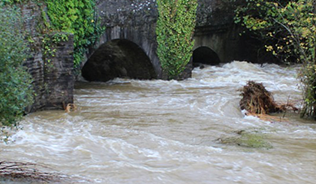It's been a busy few weeks for the Government, setting out the Autumn Budget and launching a new Industrial Strategy, whilst attempting to address the technical and political complexities of withdrawal from the European Union. Taking a temporary break from Brexit, our Policy Officer Robert Ashcroft reflects on what we've learned from these major policy statements, and their significance for the science and environment sectors.
“We can’t keep our promise to the next generation to build an economy fit for the future, unless we ensure our planet has a future.”
These were the words of the Chancellor of the Exchequer, Phillip Hammond, during his Autumn Budget speech last week. This type of reference, at the heart of a major policy statement, has been rare under this Government, but the Chancellor, with Environment Secretary Michael Gove, is clearly seeking to adjust that image.
Piggybacking on the popularity of Blue Planet II, and its remarkable sequence on the scale and impact of plastics in our oceans, the Chancellor also announced the Government would investigate how the tax system and charges on single-use plastics could be used to reduce waste. Following the success of the plastic carrier bag charge, this commitment is welcome, and we look forward to seeing how this investigation develops.
Beyond these headline statements however, the Budget was a mixed bag for the environmental observer, although there was some good news on R&D investment.
Air quality
In response to growing concern and public dissatisfaction with the air pollution problem in our towns and cities, the Chancellor announced tax rises on the purchase of diesel cars. This includes a small increase in vehicle excise duty (VED) for new diesels which don’t meet emission limits in real world testing, and a one percent increase in the company car tax diesel supplement for cars not meeting targets. However, vans are excluded from the rise in VED, and a Treasury policy paper shows that for many cars, the increase will only amount to an extra charge of £20. Such a small rise is unlikely to have much impact on consumer choices.
The money raised from these increases will go towards a new Clean Air Fund, worth £220m, which will be used to support people and businesses in adapting to new air quality measures. Defra has launched a consultation on how this fund could be used: possibilities include a targeted scrappage scheme for old diesel vehicles.
Meanwhile, despite speculation in the build-up to budget day that there may be a rise in fuel duty for the first time in eight years, Hammond again chose to freeze the rate. The Treasury’s own analysis shows that a rise in fuel duty would have generated a much higher income than VED and company car tax rises, and seems in conflict with other measures to improve air quality, including on Electric Vehicles (EVs).
There was a commitment to convert a quarter of the government’s fleet to EV by 2022, support for a new Charging Investment Infrastructure Fund to the tune of £400 million (with half each contributed by government and the private sector), and a further £100 million to ensure the Plug-in car grant continues to 2020.
Energy and climate change
On energy and climate, again a clear policy direction is hard to find in this Budget. Whilst praising the leading role the UK has had in negotiating climate change agreements, and pledging support for low emission vehicles, the Budget includes an announcement that “there will be no new low carbon electricity levies until 2025”. Not mentioned in his speech to Parliament, this change in policy puts the future of new renewable and nuclear energy projects in doubt, and has led to doubts over the UK’s ability to meet the targets set out in legally binding Carbon budgets. Furthermore, new tax benefits were promised for the North Sea oil and gas industry.
New funding has been pledged for flood defence investment: an additional £76 million to be spent over the next three years.
Science and research funding
One area of the Budget, and the Government’s subsequently released Industrial Strategy where a clear message does emerge is on funding for research and innovation. The Government is keen to position science and research at the heart of its agenda to promote growth and productivity. Of course, science also has a vital role to play in tackling the major social and environmental challenges we face, so increasing investment is welcome.
The Government’s target is to increase R&D investment to 2.4% of GDP by 2027, bringing the UK in line with its international competitors. This budget promises a further £2.3 billion of investment in 2021-22, building on the £4.7 billion announced at the Autumn Statement in 2016 (For more details on these figures, see this excellent explainer from the Campaign for Science and Engineering). This further investment is welcome, but not sufficient to maintain the UK’s position as a world leader in science and innovation: significant private investment still needs to be secured, and the Government must continue to raise its level of ambition to keep up with international competitors.
Industrial Strategy
Despite its upstaging by a royal engagement, the launch of the Government’s Industrial Strategy white paper a few days after Phillip Hammond’s budget, was an important stage in the development of this government’s policy agenda. As we have pointed out, the strategy also has great significance for environmental scientists, with its potential to embed sustainability at the heart of government. The IES submitted evidence to the Government’s green paper consultation, and have followed its development with interest.
It is pleasing to see ‘clean growth’ embedded as one of four Grand Challenges the strategy seeks to address. Noting the importance of resource efficiency and low carbon innovation, the strategy says:
“The move to cleaner economic growth – through low carbon technologies and efficient use of resources – is one of the greatest industrial opportunities of our time.” Referencing work by Ricardo Energy and Environment, the strategy notes “by one estimate, the UK’s clean economy could grow at four times the rate of GDP”.
Several early priority areas are identified to extend UK leadership in clean growth:
- Smart systems for cheap and clean energy across power, heating and transport
- Construction techniques to improve efficiency
- Innovation to make energy-intensive industry competitive in the clean economy
- High efficiency agriculture
- Finance to support clean growth.
There is also important work outlined in the plan on promoting the circular economy.
It is very positive to see these priorities established firmly at the heart of the Industrial Strategy. However, much like the Chancellor’s Budget, there are still conflicts in this strategy. Whilst calling for a shift to a clean economy, fracking is also presented as an opportunity, and it seems there is more to do to fully embed sustainability as a fundamental aim of all government policy.
Whilst a drive for a cleaner, greener, more efficient economy is to be applauded, to be taken seriously the Government must be consistent in both message and action. Yes, the Industrial Strategy and Clean Growth Plan are a good start, but to make good on their pledges to ‘build an economy fit for the future’ and ‘to leave the environment in a better state than we found it’, greater clarity and ambition is required.





